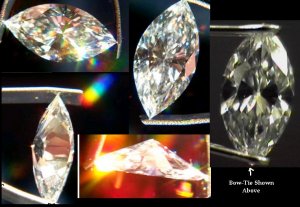blue hawaii
Rough_Rock
- Joined
- Feb 15, 2005
- Messages
- 7
Hi

I need help with these two marquise cut diamonds. Any opinion will be really appreciated due to my inexperience in buying diamonds. First time buyer, needs all the help I can get. I have seen them and I see no bow tie visible. Any suggestions??????????????
Shape: Marquise
GIA cert.
Carat weight: 1.39
Color: H
Clarity: SI1
Depth %: 62.4
Table %: 52
Symmetry: good
Polish: very good
Girdle: - med-v thk
Fluorescence: N
Measurements: 11.14 x 5.67 x 3.54
Cut: good
Great porportion
price: $6900.00
Shape: Marquise
EGL cert.
Carat weight: 1.30
Color: F
Clarity: SI1
Depth %: 65.3
Table %: 55
Symmetry: good-very good
Polish: very good
Girdle: - med-v thk
Fluorescence: N
Cut: good
Measurements: 11.26 x 5.59 x 3.65
price: $7500.
Thank You







300x240.png)